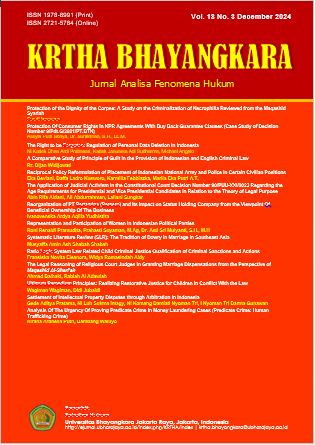Analysis of the Role of Regional Autonomy on the Existence of Customary Land under Agrarian Law in Indonesia
DOI:
https://doi.org/10.31599/krtha.v19i1.3613Keywords:
Regional Autonomy, Regional Regulations, Customary LandAbstract
Regional autonomy grants local governments greater authority in managing natural resources, including land. This raises the question of the role of regional autonomy in preserving the existence of customary land, which often faces challenges in terms of protection and recognition of its rights amidst rapid development and national land policies. The main objective of this analysis is to examine the role of regional autonomy in the existence of customary land and the legal implications of recognition by local governments regarding customary land existence through regional regulations. The approach used in this research is a normative juridical approach, with secondary materials as the primary source. Regional autonomy plays a crucial role in maintaining the existence of customary land through recognition, inventory, and identification of customary land rights, as well as protecting, receiving aspirations, and processing complaints or legal actions related to violations of these rights. Recognition by local governments of the existence of customary land through regional regulations can strengthen the position of customary law, prevent conflicts, increase awareness and participation of indigenous communities, and provide legal protection for their rights to customary land.
References
Constitution of the Republic of Indonesia
Adonia Ivonne Laturette. (2011). “The Authority of the Local Government over the Ulayat Rights of Customary Law Communities after the Enactment of Law No. 32 of 2004.” Sasi Journal, 7(3). 1-10. 10.47268/sasi.v17i3.360
Adrianus Jerabu. (2014). Recognition and Legal Protection of Customary Land Rights of Customary Law Communities in the Framework of Regional Autonomy in Colol Village, East Pocoranaka Subdistrict, East Manggarai Regency. Yogyakarta: Atma Jaya University Yogyakarta http://e-journal.uajy.ac.id/id/eprint/6154
Ahmad Arif and Agnes Rita. (2007). The Broken Wings of the Sakai. Kompas Newspaper
Alfi Taufiq Asyidqi, Sultan Alvaro Dwiyanto, and Anwar Hafidz Amrullah. (2025) “Privatization Through Building Use Rights in The Tangerang Sea Fence Area According to Positive Law.” Syiar Hukum Jurnal Ilmu Hukum, 22(2). 59-75. https://doi.org/10.29313/shjih.v22i2.14738
Amalia Syauker and Bambang Karsono. (2022). “Duality of Leadership: The Existence of Indigenous Communities, (Pakraman) in Kutuh Village, Bali Towards an Anti-Corruption and Wealthiest Village in Indonesia.” KRTHA Bhayangkara, 16(2). 415-428. https://doi.org/10.31599/krtha.v16i2.1222
Aprianti and Kasmawanti. (2020). Hukum Adat di Indonesia. Bandar Lampung: Pusaka Media
Bojonegoro Regency Government. “Regional Regulations and Regional Head Regulations.” https://satpolpp.bojonegorokab.go.id/berita/baca/14
I Ketut Drawi, Arba, and Widodo Dwi Putro. (2024). “The Existence of Customary Law Communities' Ulayat Rights to Forests After the Establishment of the Regional Regulation of North Lombik Regency Number 6 of 2020 on the Recognition and Protection of Customary Law Communities.” Jatiswara, 39(2). 209-228. https://doi.org/10.29303/jtsw.v39i2.724
I Nyoman S. (2005). Effectiveness of Regional Autonomy Policy Implementation. Jakarta: Citra Utama
Krisna Angela dan Anik Setyawati. (2022). “Analysis of the Implementation of Land Acquisition on Customary Land of Customary Law Communities in the Framework of National Strategy Projects (PSN) for the Public Interest.” Lex Generalis Law Journal, 3(3). 199-216. https://doi.org/10.56370/jhlg.v3i3.196
Law Number 5 of 1960 Concerning the Basic Regulation of Agrarian Principles
Marthinus J. Sapteno. (2007). Substantial Principles and their Function in the Formation of Laws. Surabaya: Airlangga University
M. Sofyan Pulungan. (2023). "Examining the Past, Organizing the Future: The History of Customary Law Land and its Social Conflict Handling Model." Undang: Journal of Law, 6(1), 235–267. https://doi.org/10.22437/ujh.6.1.235-267
Minister of Home Affairs Regulation No. 52/2014 on Guidelines for the Recognition and Protection of Customary Law Communities
Muhammad Bakri. (2007). TheRight to Control Land by the State. Jakarta: Citra Media
R. Soerojo Wignjodipoero. (1980). Introduction and Principles of Customary Law. Jakarta: PT Gunung Agung
Regulation of the Minister of Agrarian Affairs and Spatial Planning/National Land Agency Number 14 of 2024 on the Implementation of Land Administration and Land Registration of Customary Land Rights of Indigenous Peoples
Soejono Soekanto. (2003). Indonesian Customary Law. Jakarta: PT. Raja Grafindo Persada
Sondang P.S. (2007). Development Administration; Concept Dimensions and Strategies. Jakarta: Bumi Aksara
Sovia Hasanah. “Types, Management and Utilization of Customary Land." https://www.hukumonline.com/klinik/a/jenis--pengelolaan--dan-pemanfaatan-tanah-ulayat-lt595af37742832/
Syarifah M. (2010). Existence of Customary Land Rights in the Era of Regional Autonomy in the Sakai Community in Bengkalis Regency, Riau Province. Medan: University of North Sumatra
Tim Hukumonline. “Regional Regulation: Function, Content, and Important Aspects." https://www.hukumonline.com/berita/a/fungsi-peraturan-daerah-lt62a6fc176a0f9/?page=2
Urip Santoso. (2012). " The Existence of Management Rights under National Land Law." Mimbar Hukum Fakultas Hukum Universitas Gadjah Mada, 24(2), 275–288. https://doi.org/10.22146/jmh.16130
Downloads
Published
Issue
Section
License
Copyright (c) 2025 Mhd Azmi Farid Lubis Lubis

This work is licensed under a Creative Commons Attribution 4.0 International License.















